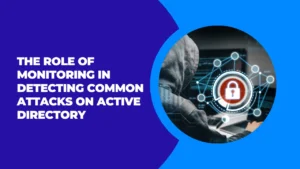Physical Address
304 North Cardinal St.
Dorchester Center, MA 02124
Physical Address
304 North Cardinal St.
Dorchester Center, MA 02124

Active Directory (AD) is a critical component of many organisations’ IT infrastructures. It is used to manage user accounts, computers, and other resources within a network. Given its importance, it’s no surprise that Active Directory is a prime target for cyber attackers.
This article explores the role of monitoring in detecting common attacks on Active Directory, helping organisations safeguard their digital environments.
Active Directory is a directory service developed by Microsoft for Windows domain networks. It provides a centralised way to manage network resources, including user accounts, security policies, and application settings.
Active Directory is crucial for organisations because it simplifies the administration of these resources and enforces security measures across the network.
Monitoring Active Directory is essential for several reasons. First, it helps detect and respond to security threats in real-time. By continuously observing AD activities, organisations can identify unusual or suspicious behaviour that may indicate an attack.
Second, monitoring provides valuable insights into network performance and helps maintain compliance with regulatory requirements.
To effectively monitor and defend against attacks, it’s crucial to understand the types of threats that Active Directory may face. Some of the most common attacks include:
Monitoring plays a pivotal role in detecting and mitigating these common attacks on Active Directory. Here’s how effective monitoring helps:
One of the primary benefits of monitoring is the ability to receive real-time alerts and notifications. Security Information and Event Management (SIEM) systems, for instance, can analyse logs from Active Directory and other network components to identify suspicious activities.
For example, if a large number of failed login attempts occur within a short period, the system can alert administrators to a potential password spraying attack.
Monitoring systems can also perform behavioural analysis to detect anomalies. For example, if an account that typically accesses only a few resources suddenly attempts to access a large number of files or systems, this could indicate a pass-the-hash attack.
Behavioural analysis helps in recognising patterns that deviate from normal operations, providing early warnings of potential threats.
Active Directory generates numerous logs related to user activities, authentication attempts, and system changes. Monitoring tools can analyse these logs to identify unusual patterns or signs of compromise. For example, if there are multiple logon attempts from an unfamiliar IP address, this could indicate a Kerberos ticket theft or a domain controller compromise.
Effective monitoring involves correlating events from various sources. By combining data from Active Directory, network devices, and other security tools, administrators can gain a comprehensive view of potential threats. For instance, if a security tool detects an unusual login pattern and a network intrusion detection system identifies abnormal traffic, correlating these events can help pinpoint an ongoing attack.
Maintaining audit trails is another critical aspect of monitoring. These trails record all activities within Active Directory, including changes to user accounts and permissions. By reviewing audit trails, administrators can trace the actions of suspected attackers and understand how they gained access to the system. This information is valuable for both detecting attacks and conducting post-incident investigations.
To effectively monitor Active Directory and detect common attacks, organisations should follow these best practices:
Before monitoring for anomalies, it’s essential to establish a baseline of normal activity. This involves understanding typical user behaviour, network traffic patterns, and system performance. By having a clear baseline, it becomes easier to identify deviations that may indicate an attack.
There are various tools available for monitoring Active Directory. Security Information and Event Management (SIEM) systems, intrusion detection systems (IDS), and endpoint protection platforms can all play a role. Choose tools that offer comprehensive monitoring capabilities and can integrate with Active Directory.
Monitoring policies should not be static. Regularly review and update these policies to adapt to changing threats and evolving network environments. Ensure that monitoring tools are configured to capture relevant data and that alerts are set up to notify administrators of potential issues.
Regular security audits help ensure that monitoring systems are functioning correctly and that security policies are being enforced. These audits can also identify gaps in monitoring coverage and provide opportunities for improvement.
Ensure that your IT staff is trained in recognising and responding to security threats. Effective monitoring is not just about having the right tools but also about having knowledgeable personnel who can interpret data and take appropriate actions.
Despite its importance, monitoring Active Directory can be challenging. Some common challenges include:
Monitoring plays a crucial role in detecting and responding to common attacks on Active Directory. By implementing effective monitoring practices, organisations can enhance their ability to identify suspicious activities, respond to threats in real-time, and maintain a secure network environment.
While challenges exist, the benefits of robust monitoring far outweigh the risks. By staying vigilant and continuously improving monitoring strategies, organisations can better protect their Active Directory infrastructure and safeguard their digital assets.